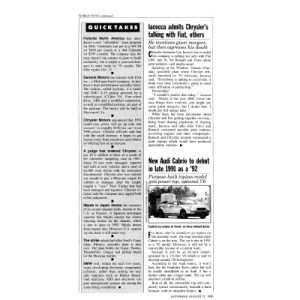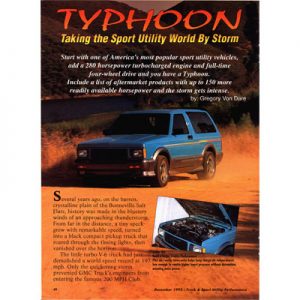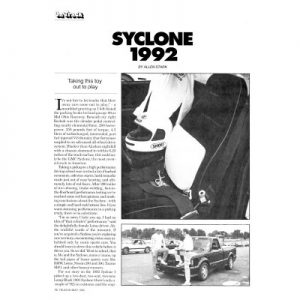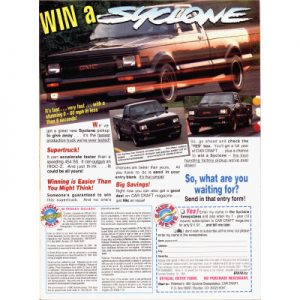Popular Hot Rodding
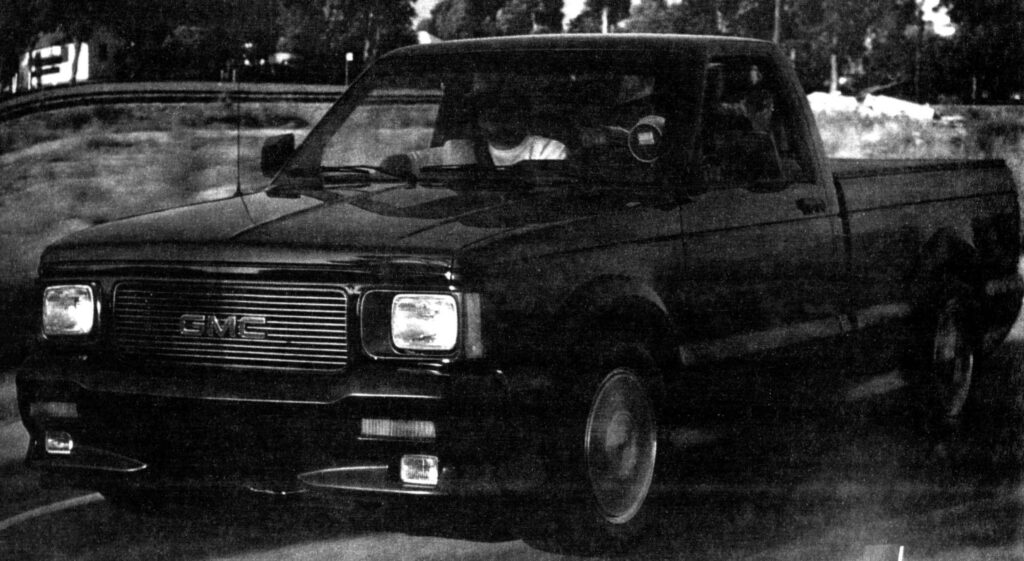
By MATT HARDESTY
Within the last few years, trucks. or pickups as many pref er to call them. have changed dramatically in both exterior and interior design. Square outward looks. bare interior accommodations. rough rides and low-geared, high-torque six-cylinder motors have given way to awe-inspiring. new-generation sport trucks like the Chevy 454 SS. Although this change in the present-day truck market has come as a breath of fresh air, nothing. but nothing has blown away all of the traditional rules like the GMC Syclone.
Bursting upon the performance automotive scene early last year. the new Syclone promised a horsepower-hungry public a versatile vehicle that could haul a heavy load as well as a hot quarter-mile. After a seemingly endless wait, the swift little Syclone finally made it to selected GMC dealers across the country, and just as everyone expected, this all-wheel- drive, 4.3-liter V6 turbo S-15 was very impressive … but not perfect.
For most performance-minded people who invested their hard-earned cash into this radically new sport truck, the most disappointing aspect of the Syclone was the maze of confusion and disarray of hoses, wires and electrical components under the hood. It seemed the Syclone’s new “International” motor would be more of a “foreign” nightmare when it came time to change the plugs or any other maintenance-related necessities. Customers who thought the addition of performance racing equipment to the Syclone would be as simple as those used on the ever-popular turbo Grand Nationals soon realized how terribly mistaken they were this was definitely not a turbo Buick.
So where does one begin to look for added performance in a Syclone? A chip? Bigger turbo? Intercooler? This was the same question posed by Kenne Bell Performance Products in Rancho Cucamonga, California (714/941-6646). Kenne Bell’s name is synonymous with Buick performance, whether it be V6, V8 or turbo power, but when the Syclone arrived, Kenne Bell shifted gears to develop the first performance racing bolt-ons for this stout turbo truck.
Before attacking any such project, the first and most important step is understanding what you’re working on. In this case, the turbo 4.3 V6 in the Syclone is basically a stock motor with a few alterations, most importantly the turbo. The 4.3-liter block has the same basic internal dimensions as the standard 5.7- liter Chevy 350; the heads and camshaft are carry-over features from the standard Vortec 4.3-liter, normally-aspirated engine. The Syclone motor differs dramatically from the standard Vortec motor thanks in part to the Mitsubishi TD06 turbo, a liquid-to-air intercooler, port fuel injection and GM High Energy Ignition System with Electronic Spark Control to alleviate dangerous knock and ping. What this equates to is a system similar to Buick’s turbo V6 (a system with which Kenne Bell is very familiar with), although the packaging in the Syclone is much more crowded and slightly more complicated.
Kenne Bell’s president, Jim Bell, has spent much time and effort in understanding and improving the new Syclone and its 280-horsepower motor. Numerous baseline tests on a stock Syclone were conducted at Los Angeles County Raceway in Palmdale, California, by Jim and his staff to determine how they could pull extra horsepower out of a seemingly caged animal. Just as a doctor uses specialized and sensitive equipment to check patients the Kenne Bell Syclone was monitored by some pretty advanced computer equipment from Race and Performance Monitoring (RPM) in Scottsdale, Arizona (602/483-7885). RPM’s DS-1000 computer data-logging equipment was used to determine such functions as: speed, rpm, boost, throttle position, exhaust temperature, exhaust pressure, manifold air temperature, fuel pressure and a host of other engine functions and temperatures. This system proved to be invaluable in determining the Syclone’s weak areas as it blasted down the quarter mile.
Initial quarter-mile times for the stock Kenne Bell truck were very quick, just as anticipated: 13.48 @ 96.80 mph. Knowing full well that the Syclone was not performing to its full capabilities, Jim set to work on a flurry of various bolt-ons guaranteed to increase power and decrease ET’s. The first modification to the Syclone was the addition of a billet aluminum adjustable fuel pressure regulator. The regulator allowed for a higher idle pressure (50 psi over 40 psi stock) and increased wide-open throttle fuel pressure (70 psi over 60 psi stock) that effectively reduced detonation during heavy acceleration and eliminated low-rpm surge and bog.
The next step involved experimentation with performance computer chips but, unlike most GM computer chips, the one used on the Syclone is very different in size and shape. Two new performance chips were created: the Streetmaster and the Shoot Out 1. Both increased power and proved to be effective in lowering ETs well into the 12s, although the Streetmaster requires 94-octane fuel and the Shoot Out 1 should be used with racing fuel or aviation gas only. To complement the new chips, the twisted, restricted and utterly useless stock air intake was removed in favor of a high-flow unit necessitating the use of a smaller battery to create more space for a better fit.
To find out how the Syclone would react to a free-flowing exhaust, the stock dual mufflers and tailpipes were removed and replaced with a three-inch-diameter straight pipe bolted directly to the stock catalytic converter. This not only shaved quarter- mile times, but weighed 30 pounds less than the stock exhaust.
Experimentation with the electronic lock-up torque converter and an override switch that locks up the converter in second gear was good for another two tenths. The addition of an 11-inch hi-stall converter was also a step in the right direction and proved to reduce ET’s another two tenths.
The three largest improvements that pushed the Syclone into the 11- second range were the Stage 2C turbo upgrade kit (larger Garrett turbo), Mark 1TR Turbo Roller Cam (.440 lift, 205 duration, compared to .345 lift 176 duration stock), and the Turbo Swirl Ported Heads. The larger Garrett turbo provides increased boost over the stock Mitsubishi unit due in part to its obviously larger turbine and compressor. The roller cam replaces the stock cam used on the normally-aspirated 4.3-liter engines; an obvious gain was anticipated with the new cam and its addition pushed the Syclone to a blistering quartermile time of 11.99 © 110.57. The aluminum Chevrolet heads provide dramatic airflow increases for both intake and exhaust, and because the stock heads are of “‘fast burn design they tend to be more prone to detonation. The stock heads utilize a straight-in spark plug insertion while the aluminum heads use an angle installation; this difference in spark plug placement requires the use of Kenne Bell headers on the aluminum heads in order to clear the spark plugs. This last addition has dropped the Syclone ‘s ET nearly two tenths lower to 11.74.
If you thought the Syclone was impressive in stock form, the Kenne Bell-treated truck will rearrange your definition of “impressive” in a big hurry. Those planning to race their Syclones will find these new performance pieces to be an absolute must since they help take out much of the guesswork and labor in trying to understand the new 4.3 turbo V6. Additional good news for Syclone owners comes from the fact that Kenne Bell is developing more goodies including a trick ram-air intercooler planned to replace the stock liquid-to-air unit, and, as this story was going to press, Jim Bell informed us that the Syclone has improved its time further thanks to an additional turbo upgrade that surpasses their present offering. Kenne Bell has also designed a four-gauge bezel that fits directly in front of the automatic shifter, providing for instant and accurate information on boost, oil pressure, temperature and fuel pressure.
If you’ve got a Syclone and an itch to win races at the drags, Kenne Bell’s got everything you need to rocket your turbo truck from super status to supersonic in no time at all unless, of course, you count the 11.74 seconds it will take your reborn Syclone to run the quarter mile.
Here’s the Kenne Bell-equipped Syclone turbo V6 with all of the performance pieces installed. As you can see, the only visible change is that of the hi-flow air In take and filter (note the low profile battery used to provide more clearance for the air-intake tube).
Race and Performance Monitoring’s (RPM) DS- 1000 Datalogging computer equipment was installed on the Kenne Bell Syclone to determine the engine’s performance on each quarter-mile run. Critical engine functions are monitored by sensors that relay information back to the computer storing it for inspection after a run. The system reveals such functions as boost, speed, fuel pressure, intake air temperature, intercooler air temperature, rpm and a host of others.
The information recorded by the on board computer is then displayed on a standard computer screen using RPM’S specialized software. The engine functions are displayed in a gauge format for easy interpretation.
The stock, restrictive and twisted air In take hose is dysfunctional at best and easily replaced with Kenne Bell Hi-Flo units shown here. The short filter attaches easily to the stock air in take tube shown here white the longer filter attaches to the Kenne Bell Ram Air system that utilizes cool air from the front of the truck.
Kenne Bell’s basic performance kit for the Syclone includes: electronic torque converter override switch, adjustable fuel pressure regulator, 160′ degree thermostat, oil filler breather cap and a performance chip like the Streetmaster or Shoot Out.
muffler/catalytic converter exhaust system used on the Syclone. The Kenne Bell Syclone dropped 30 pounds of excess weight and gained a tenth of a second in the quarter mile with the addition of a three-inch straight pipe exhaust bolted directly to the stock catalytic converter.
When combined with the adjustable fuel pressure regulator, this high-volume replacement pump provides the turbo motor with the extra fuel necessary to reduce bogging, hesitation and detonation.
To further increase cooling on the stock and very unique intercooler, a manually controlled fan was attached to the lower intercooler radiator.
The stock cam in the Syclone turbo V6 is the same camshaft used in the normally aspirated Vortec V6. As one might imagine, a cam better suited to the needs of a high-horsepower motor is sure to increase both power and performance. Such is the case with the Kenne Bell 1TR Turbo Roller Cam pictured here.
The stock Mitsubishi TD06 turbo works well with the stock motor, but with performance modifications, the Syclone’s V6 requires more air that only a larger turbo can provide. The Kenne Bell Stage 2C Turbo Upgrade Kit consists of a visibly larger Garrett turbo equipped with an external, vacuum-operated wastegate control. This improvement netted two more miles per hour and two tenths of a second in the quarter mile.
Kenne Bell offers their Turbo Swirl Ported aluminum Chevrolet heads that substantially out flow the poor breathing, detonation prone stock cast Iron heads. To use these heads, though, custom headers from Kenne Bell must be used due to spark plug clearance.
Kenne Bell offers forged replacement pistons for the Syclone that are substantially stronger than the stockers. The forged piston (right) is visibly different and able to withstand increased stress from the upgraded motor.
To keep abreast of all the engine’s vital signs, a trick console gauge package like the one shown displays oil pressure, temperature, boost and fuel pressure, plus It provides four rocker switches to control the electronic torque converter, intercooler fan, inter cooler water pump and fuel pump cutoff.
High-volume 40-pound injectors are also available and provide more reliable operation over the pintle-type stock injectors. The high-volume injector (left) uses a very efficient flap-type mechanism as compared to the stock pin tie type that suffers from buildup and clogging.
The stock governor on the Syclone’s 700R4 transmission is good for 3800rpm shift points (right), but with the addition of the roller cam, a higher rpm shift is necessary. To achieve the needed 5000 rpm shift, Kenne also designed a high-rpm shift governor shown here on the left.


